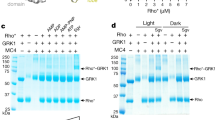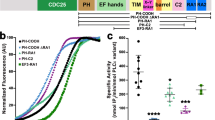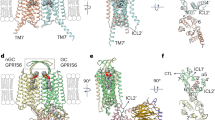Abstract
The enzyme phospholipase C-β (PLCβ) is a crucial regulator of intracellular calcium levels whose activity is controlled by heptahelical receptors that couple to members of the Gq family of heterotrimeric G proteins. We have determined atomic structures of two invertebrate homologs of PLCβ (PLC21) from cephalopod retina and identified a helix from the C-terminal regulatory region that interacts with a conserved surface of the catalytic core of the enzyme. Mutations designed to disrupt the analogous interaction in human PLCβ3 considerably increase basal activity and diminish stimulation by Gαq. Gαq binding requires displacement of the autoinhibitory helix from the catalytic core, thus providing an allosteric mechanism for activation of PLCβ.
This is a preview of subscription content, access via your institution
Access options
Subscribe to this journal
Receive 12 print issues and online access
$189.00 per year
only $15.75 per issue
Buy this article
- Purchase on Springer Link
- Instant access to full article PDF
Prices may be subject to local taxes which are calculated during checkout



Similar content being viewed by others
References
Rhee, S.G. Regulation of phosphoinositide-specific phospholipase C. Annu. Rev. Biochem. 70, 281–312 (2001).
Rebecchi, M.J. & Pentyala, S.N. Structure, function, and control of phosphoinositide-specific phospholipase C. Physiol. Rev. 80, 1291–1335 (2000).
Taylor, S.J. & Exton, J.H. Two a subunits of the Gq class of G proteins stimulate phosphoinositide phospholipase C-β1 activity. FEBS Lett. 286, 214–216 (1991).
Smrcka, A.V., Hepler, J.R., Brown, K.O. & Sternweis, P.C. Regulation of polyphosphoinositide-specific phospholipase C activity by purified Gq . Science 251, 804–807 (1991).
Park, D., Jhon, D.Y., Lee, C.W., Lee, K.H. & Rhee, S.G. Activation of phospholipase C isozymes by G protein βγ subunits. J. Biol. Chem. 268, 4573–4576 (1993).
Boyer, J.L., Waldo, G.L. & Harden, T.K. βγ-subunit activation of G-protein-regulated phospholipase C. J. Biol. Chem. 267, 25451–25456 (1992).
Smrcka, A.V. & Sternweis, P.C. Regulation of purified subtypes of phosphatidylinositol-specific phospholipase C β by G protein α and βγ subunits. J. Biol. Chem. 268, 9667–9674 (1993).
Sternweis, P.C. & Smrcka, A.V. G proteins in signal transduction: the regulation of phospholipase C. Ciba Found. Symp. 176, 96–106, discussion 106–111 (1993).
Illenberger, D. et al. Stimulation of phospholipase C-β2 by the Rho GTPases Cdc42Hs and Rac1. EMBO J. 17, 6241–6249 (1998).
Harden, T.K., Hicks, S.N. & Sondek, J. Phospholipase C isozymes as effectors of Ras superfamily GTPases. J. Lipid Res. 50, S243–S248 (2009).
Sugden, P.H. & Clerk, A. Cellular mechanisms of cardiac hypertrophy. J. Mol. Med. 76, 725–746 (1998).
Berridge, M.J. Cardiac calcium signalling. Biochem. Soc. Trans. 31, 930–933 (2003).
Ju, H., Zhao, S., Tappia, P.S., Panagia, V. & Dixon, I.M. Expression of Gqα and PLC-β in scar and border tissue in heart failure due to myocardial infarction. Circulation 97, 892–899 (1998).
Woodcock, E.A., Kistler, P.M. & Ju, Y.-K. Phosphoinositide signalling and cardiac arrhythmias. Cardiovasc. Res. 82, 286–295 (2009).
Schneuwly, S., Burg, M.G., Lending, C., Perdew, M.H. & Pak, W.L. Properties of photoreceptor-specific phospholipase C encoded by the norpA gene of Drosophila melanogaster. J. Biol. Chem. 266, 24314–24319 (1991).
Mitchell, J., Gutierrez, J. & Northup, J.K. Purification, characterization, and partial amino acid sequence of a G protein-activated phospholipase C from squid photoreceptors. J. Biol. Chem. 270, 854–859 (1995).
Shortridge, R.D. et al. A Drosophila phospholipase C gene that is expressed in the central nervous system. J. Biol. Chem. 266, 12474–12480 (1991).
Essen, L.O. et al. Structural mapping of the catalytic mechanism for a mammalian phosphoinositide-specific phospholipase C. Biochemistry 36, 1704–1718 (1997).
Ellis, M.V. et al. Catalytic domain of phosphoinositide-specific phospholipase C (PLC). Mutational analysis of residues within the active site and hydrophobic ridge of PLCδ1. J. Biol. Chem. 273, 11650–11659 (1998).
Suh, P.G. et al. Multiple roles of phosphoinositide-specific phospholipase C isozymes. BMB Rep. 41, 415–434 (2008).
Jezyk, M.R. et al. Crystal structure of Rac1 bound to its effector phospholipase C-β2. Nat. Struct. Mol. Biol. 13, 1135–1140 (2006).
Hicks, S.N. et al. General and versatile autoinhibition of PLC isozymes. Mol. Cell 31, 383–394 (2008).
Waldo, G.L. et al. Kinetic scaffolding mediated by a phospholipase C-β and Gq signaling complex. Science 330, 974–980 (2010).
Zhang, W. & Neer, E.J. Reassembly of phospholipase C-β2 from separated domains: analysis of basal and G protein-stimulated activities. J. Biol. Chem. 276, 2503–2508 (2001).
Schnabel, P. & Camps, M. Activation of a phospholipase Cβ2 deletion mutant by limited proteolysis. Biochem. J. 330, 461–468 (1998).
Ilkaeva, O., Kinch, L.N., Paulssen, R.H. & Ross, E.M. Mutations in the carboxyl-terminal domain of phospholipase C-β1 delineate the dimer interface and a potential Gαq interaction site. J. Biol. Chem. 277, 4294–4300 (2002).
Kim, C.G., Park, D. & Rhee, S.G. The role of carboxyl-terminal basic amino acids in Gqα-dependent activation, particulate association, and nuclear localization of phospholipase C-β1. J. Biol. Chem. 271, 21187–21192 (1996).
Park, D., Jhon, D.Y., Lee, C.W., Ryu, S.H. & Rhee, S.G. Removal of the carboxyl-terminal region of phospholipase C-β1 by calpain abolishes activation by Gαq . J. Biol. Chem. 268, 3710–3714 (1993).
Singer, A.U., Waldo, G.L., Harden, T.K. & Sondek, J. A unique fold of phospholipase C-β mediates dimerization and interaction with Gαq . Nat. Struct. Biol. 9, 32–36 (2002).
Paulssen, R.H., Woodson, J., Liu, Z. & Ross, E.M. Carboxyl-terminal fragments of phospholipase C-β1 with intrinsic Gq GTPase-activating protein (GAP) activity. J. Biol. Chem. 271, 26622–26629 (1996).
Wu, D., Jiang, H., Katz, A. & Simon, M.I. Identification of critical regions on phospholipase C-β1 required for activation by G-proteins. J. Biol. Chem. 268, 3704–3709 (1993).
Koyanagi, M., Ono, K., Suga, H., Iwabe, N. & Miyata, T. Phospholipase C cDNAs from sponge and hydra: antiquity of genes involved in the inositol phospholipid signaling pathway. FEBS Lett. 439, 66–70 (1998).
Jhon, D.Y. et al. Cloning, sequencing, purification, and Gq-dependent activation of phospholipase C-β3. J. Biol. Chem. 268, 6654–6661 (1993).
Shankaranarayanan, A. et al. Assembly of high order Gαq-effector complexes with RGS proteins. J. Biol. Chem. 283, 34923–34934 (2008).
Gu, S. et al. Unique hydrophobic extension of the RGS2 amphipathic helix domain imparts increased plasma membrane binding and function relative to other RGS R4/B subfamily members. J. Biol. Chem. 282, 33064–33075 (2007).
Hepler, J.R. et al. Purification from Sf9 cells and characterization of recombinant Gqα and G11α. Activation of purified phospholipase C isozymes by Gα subunits. J. Biol. Chem. 268, 14367–14375 (1993).
Lee, S.B., Shin, S.H., Hepler, J.R., Gilman, A.G. & Rhee, S.G. Activation of phospholipase C-β2 mutants by G protein αq and βγ subunits. J. Biol. Chem. 268, 25952–25957 (1993).
Philip, F., Kadamur, G., Silos, R.G., Woodson, J. & Ross, E.M. Synergistic activation of phospholipase C-β3 by Gαq and Gβγ describes a simple two-state coincidence detector. Curr. Biol. 20, 1327–1335 (2010).
Woodcock, E.A. et al. Selective activation of the 'b' splice variant of phospholipase Cβ1 in chronically dilated human and mouse atria. J. Mol. Cell Cardiol. 47, 676–683 (2009).
Achour, L., Labbe-Jullie, C., Scott, M.G. & Marullo, S. An escort for GPCRs: implications for regulation of receptor density at the cell surface. Trends Pharmacol. Sci. 29, 528–535 (2008).
Jenco, J.M., Becker, K.P. & Morris, A.J. Membrane-binding properties of phospholipase C-β1 and phospholipase C-β2: role of the C-terminus and effects of polyphosphoinositides, G-proteins and Ca2+. Biochem. J. 327, 431–437 (1997).
Anderson, C.M., Zucker, F.H. & Steitz, T.A. Space-filling models of kinase clefts and conformation changes. Science 204, 375–380 (1979).
Daniel, R.M. The upper limits of enzyme thermal stability. Enzyme Microb. Technol. 19, 74–79 (1996).
Wu, D., Katz, A. & Simon, M.I. Activation of phospholipase Cβ2 by the α and βγ subunits of trimeric GTP-binding protein. Proc. Natl. Acad. Sci. USA 90, 5297–5301 (1993).
Hurley, J.B. Molecular properties of the cGMP cascade of vertebrate photoreceptors. Annu. Rev. Physiol. 49, 793–812 (1987).
Slep, K.C. et al. Structural determinants for regulation of phosphodiesterase by a G protein at 2.0 Å. Nature 409, 1071–1077 (2001).
Arshavsky, V.Y., Lamb, T.D. & Pugh, E.N. Jr. G proteins and phototransduction. Annu. Rev. Physiol. 64, 153–187 (2002).
Sunahara, R.K. & Taussig, R. Isoforms of mammalian adenylyl cyclase: multiplicities of signaling. Mol. Interv. 2, 168–184 (2002).
Biddlecome, G.H., Berstein, G. & Ross, E.M. Regulation of phospholipase C-β1 by Gq and m1 muscarinic cholinergic receptor. Steady-state balance of receptor-mediated activation and GTPase-activating protein-promoted deactivation. J. Biol. Chem. 271, 7999–8007 (1996).
Tesmer, V.M., Kawano, T., Shankaranarayanan, A., Kozasa, T. & Tesmer, J.J. Snapshot of activated G proteins at the membrane: the Gαq-GRK2-Gβγ complex. Science 310, 1686–1690 (2005).
Chan, P. et al. Purification of heterotrimeric G protein α subunits by GST-Ric-8 association: primary characterization of purified Gαolf . J. Biol. Chem. 286, 2625–2635 (2011).
Mezzasalma, T.M. et al. Enhancing recombinant protein quality and yield by protein stability profiling. J. Biomol. Screen. 12, 418–428 (2007).
Ghosh, M. & Smrcka, A.V. Assay for G protein-dependent activation of phospholipase Cβ using purified protein components. Methods Mol. Biol. 237, 67–75 (2004).
Acknowledgements
We thank E. Ross (University of Texas Southwestern Medical Center at Dallas) for the vector encoding human PLCβ3, and G. Tall (University of Rochester) for the baculovirus vector expressing glutathione S-transferase (GST)-tagged Ric8A and for insight into how to increase yields of Gαq, before publication of his work. We also thank P. Backlund (Section on Mass Spectrometry and Metabolism, National Institute of Child Health & Human Development) for mass spectrometry of PLC21 samples. This work was supported by US National Institutes of Health grants HL071818 and HL086865 (J.J.G.T.) and by the Intramural Research program of the National Institute on Deafness and Other Communication Disorders, US National Institutes of Health (J.K.N.). Our research used the Cell and Molecular Biology Core of the Michigan Diabetes Research and Training Center, supported by DK20572. Use of the Advanced Photon Source at Argonne National Laboratory was supported by the US Department of Energy, Office of Science, Office of Basic Energy Sciences, under contract no. DE-AC02-06CH11357. Use of the LS-CAT Sector 21 was supported by the Michigan Economic Development Corporation and Michigan's Technology Tri-Corridor (grant 085P1000817).
Author information
Authors and Affiliations
Contributions
A.M.L., V.M.T., J.K.N. and J.J.G.T. designed the overall experimental approach. J.G., S.C. and J.K.N. purified LPLC21 and SPLC21, and cloned and sequenced cDNA encoding SPLC21. K.C.S. crystallized LPLC21. A.M.L. crystallized SPLC21 and determined the crystal structures of LPLC21 and SPLC21. A.M.L. and V.M.T. cloned, expressed and purified human PLCβ3 variants. V.M.T. cloned, expressed and purified Gαq. A.M.L. did all activity-based assays. D.M.T. helped design and, together with V.D.D., conducted Thermo Fluor and FCPIA assays. A.M.L., V.M.T. and J.J.G.T. wrote the manuscript.
Corresponding authors
Ethics declarations
Competing interests
The authors declare no competing financial interests.
Supplementary information
Supplementary Text and Figures
Supplementary Figures 1–5, Supplementary Table 1 and Supplementary Methods (PDF 1095 kb)
Rights and permissions
About this article
Cite this article
Lyon, A., Tesmer, V., Dhamsania, V. et al. An autoinhibitory helix in the C-terminal region of phospholipase C-β mediates Gαq activation. Nat Struct Mol Biol 18, 999–1005 (2011). https://doi.org/10.1038/nsmb.2095
Received:
Accepted:
Published:
Issue Date:
DOI: https://doi.org/10.1038/nsmb.2095
This article is cited by
-
Structure of phospholipase Cε reveals an integrated RA1 domain and previously unidentified regulatory elements
Communications Biology (2020)
-
Crystal structure of human PLD1 provides insight into activation by PI(4,5)P2 and RhoA
Nature Chemical Biology (2020)
-
Full-length Gαq–phospholipase C-β3 structure reveals interfaces of the C-terminal coiled-coil domain
Nature Structural & Molecular Biology (2013)
-
Immune regulation by phospholipase C-β isoforms
Immunologic Research (2013)



